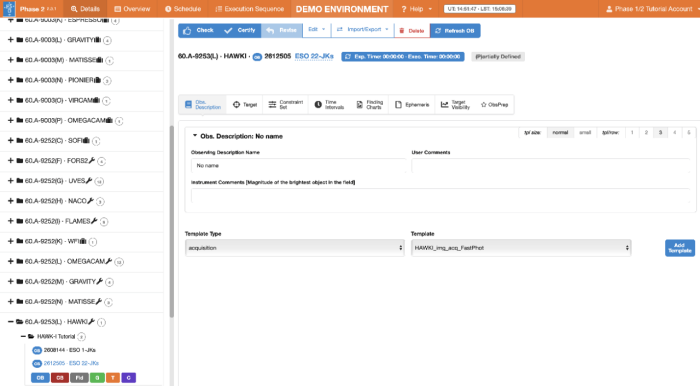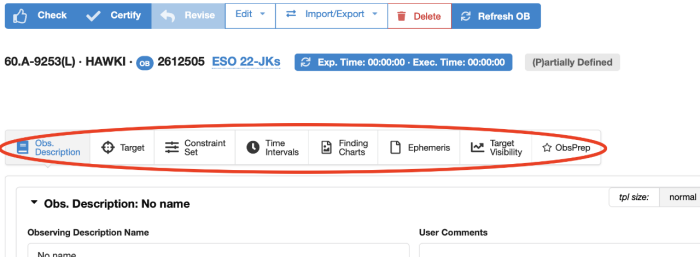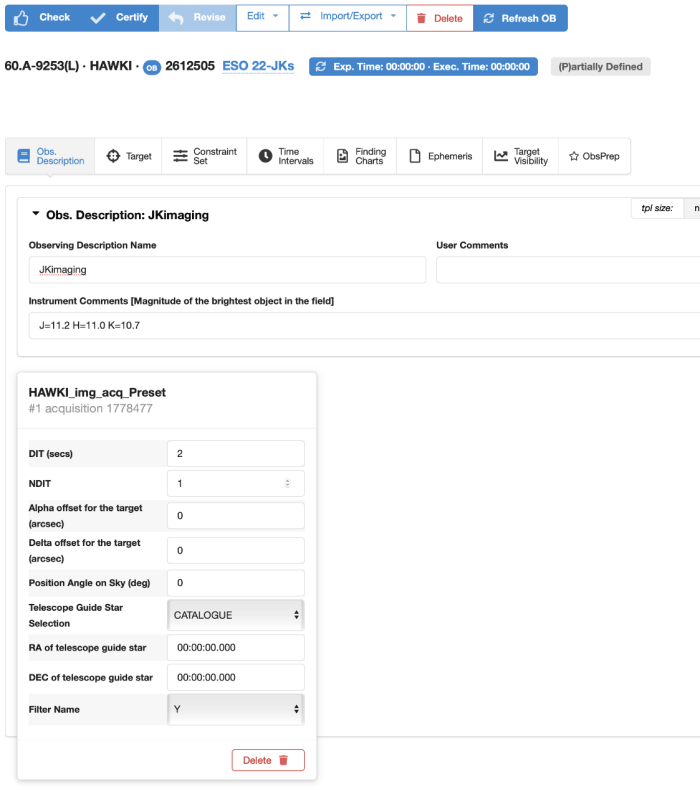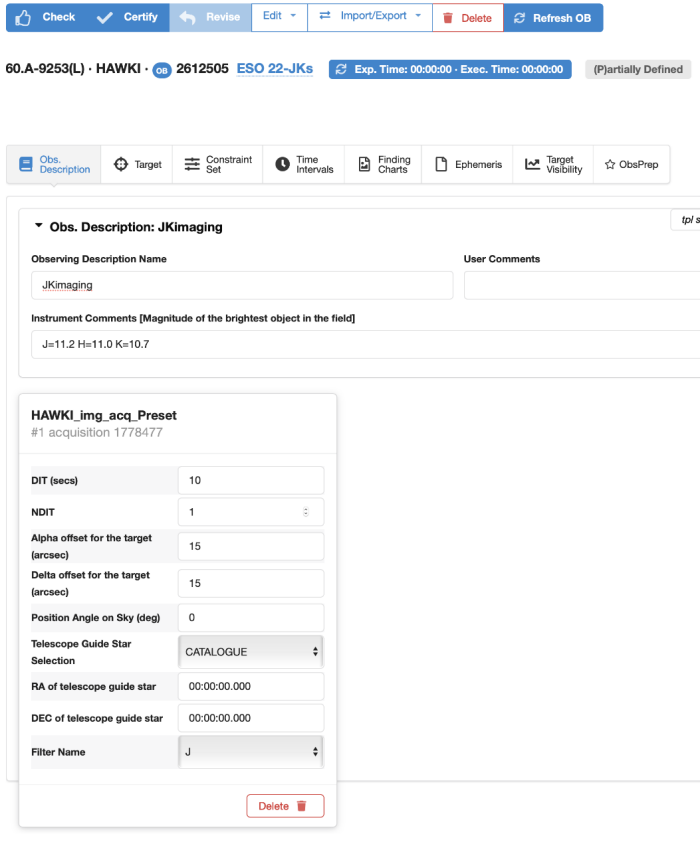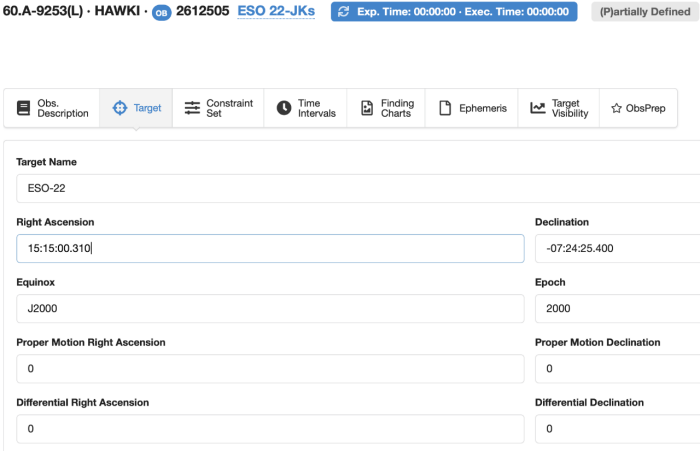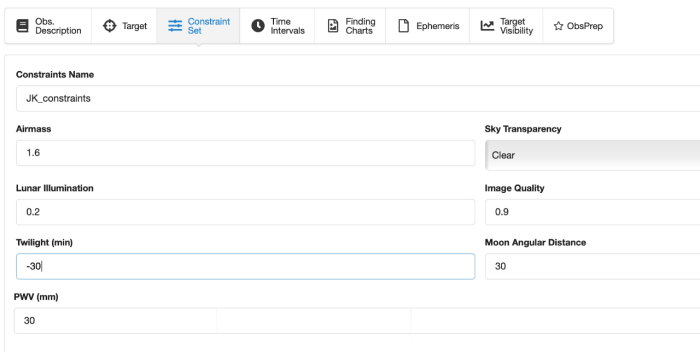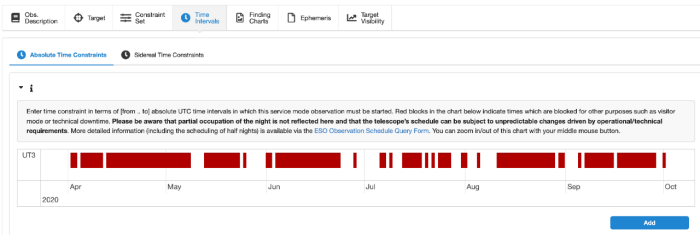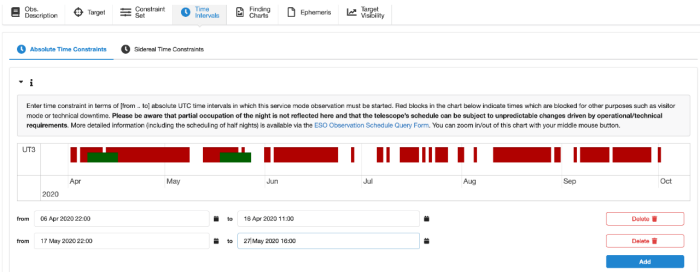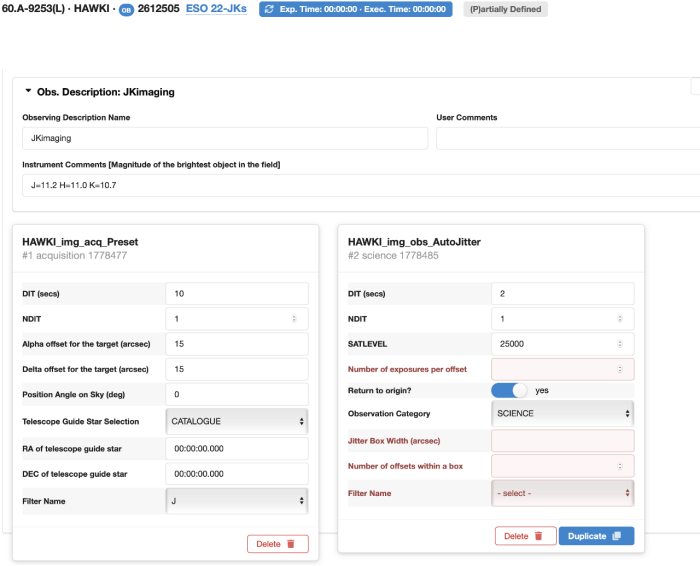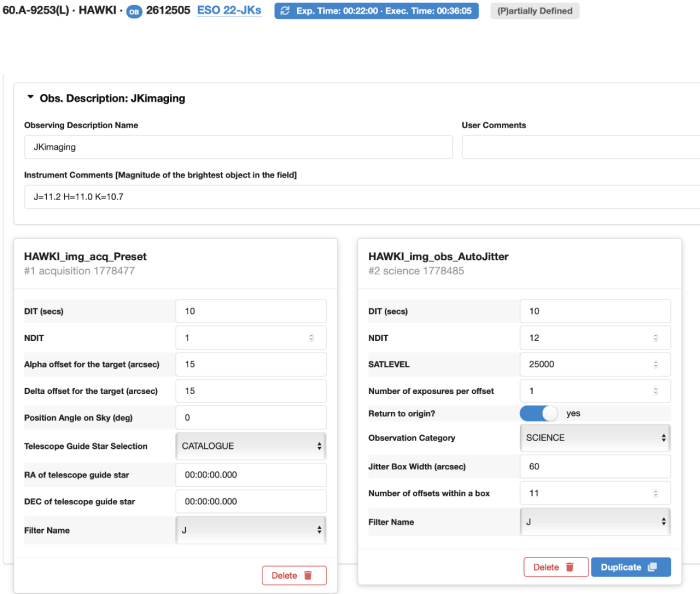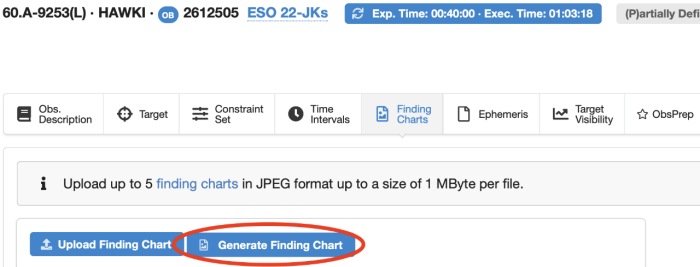Observation of sparse fields
When the science target is located in a sparse field then the standard practice is to resort to the jitter technique. Sky frames can be estimated from the object frames themselves. In practice, a running sky is built from ~ 5 frames (Note: the minimum number of object frames is 3), that were taken immediately before and after the frame from which the sky is being estimated. All sky subtracted frames are then co-added with adequate shifts to form the final image. In what follows we will show an example for such observing strategy (i.e. jittering technique), which is suitable in case of sparse fields. In particular, we will use an observing template called AutoJitter that allows you to take a number of object frames shifted by relatively small offsets. However, this observing strategy can be also performed by using a different template called GenericOffset. The reader should hence refer to the HAWK-I template manual as well as to the HAWK-I User manual to decide what template is most suitable.
If the characteristics of your science target do not allow you to use the jittering technique then click here to go back to the HAWK-I main tutorial page where you can find other examples for HAWK-I observations.
0: Goal of the Run
In this tutorial we will prepare an OB that performs imaging observation of a cosmological field in the JKs filters. Your goal here is to obtain photometric redshift for a number of galaxies in a cluster whose approximate center is at RA(2000) = 15 15 00.31 and DEC(2000) = -07 24 25.4. For convenience hereafter we will call the cluster ESO-22 (Note: This is a fictional galaxy cluster).
The sample OB will illustrate the use of a variety of features of p2 and illustrate the kind of decisions to be taken at the time of preparing in advance of an observing run, as well as some aspects that are specific to the preparation of OBs for HAWK-I.
1: Getting started
The Phase 2 process begins when you receive an email from the ESO Observing Programs Office (OPO) telling you that the allocation of time for the coming observing period has finalized and that you can view the results by logging in to the UserPortal and clicking on "Check the webletters." Note that the username and password that you need to use for the User Portal are the same as those you will use to prepare your OBs.
You follow the instructions given by ESO and find that time was allocated to your run with HAWK-I. Therefore, you decide to start preparing your Phase 2 material. First, you collect all the necessary documentation:
- The HAWK-I User Manual
- The HAWK-I Template Manual
- The Service Mode instructions for VLT/VLTI and VISTA
- The p2 Documentation
and you proceed with opening the p2 application in your browser. For the sake of this tutorial, we will use the p2 demo application: https://www.eso.org/p2demo
This is a special facility that ESO has set up so that users who do not have their own p2 login data can still use p2 and prepare example OBs (for example, while writing a proposal to get the overheads right!). Indeed, all users have access to the same facility, and each can see what all others have done. You cannot use p2demo to prepare actual OBs intended to be executed. When you prepare actual OBs you should use your ESO User Portal credentials for p2 (with http://www.eso.org/p2).
2: Your First OB
Now, you start with the definition of an OB for your science target.
2.1: Define an OB with p2
After browsing to https://www.eso.org/p2demo, the p2 main GUI will appear as follows:
Runs for a number of instruments appear in the "Your Observing runs" area, since the same tutorial account is used for all of them. Similarly, if you log in with your own User Portal ID, then you will get the list of all the runs in which you are PI.
Select the folder corresponding to the HAWK-I Tutorial run, 60.A-9253(L). In this tutorial we assume that time was allocated in Service Mode. This is indicated by the wrench symbol that appears next to the RunID of the HAWK-I run.
You can now start defining your OB.
Expand the HAWK-I run folder by clicking on the + sign. Then, create a new Folder, expand it, and click on the OB blue icon. This creates and opens a new OB on the right in the main OB view window.
Now the next step should be naming the OB, however because in some special cases a particular prefix must be given to an observing OB, you check first on the Service Mode Guidelines webpage if a special naming convention must be given to your HAWK-I imaging OB. Consulting that page you confirm that your observations do not need any particular OB naming prefix, because it is neither a target-of-opportunity object, nor moving asteroid, nor anything else that would require a particular OB naming prefix. Hence, you decide to name your OB: ESO 22-JKs. Select the OB and replace (in the right hand large OB view window) "No Name" with ESO 22-JKs and press enter.
In p2 you should then see the window as follows:
Next, you will fill in all the information related to the observation by clicking on the different tabs (ObsDescription, target, Constraint Set, Time intervals, etc.)
2.1.1: Obs. Description-Filling in the Basic Information
OD Name
It may be useful in many cases to have an easy way of identifying an OD (Observing Description), like when having observations of a number of targets performed with an identical instrument configuration and observation template parameters. The OD Name field allows you to define names for the ODs. The OD name appears in turn in the overview area of the p2 folder of this run, thus allowing the identification at a glance of all OBs sharing ODs with the same name. In this tutorial the observation description will define the imaging observations at J and Ks filters. Thus, we enter the name JKimaging in the OD Name field.
User Comments
The User Comments field can be used for any information you wish, to keep further track of the characteristics of the OB, to alert the staff on Paranal to special requirements, etc. Here, we do not have any special information or requirements and leave this field blank.
Instrument Comments
The HAWK-I specific field refers to the Magnitude of the brightest object in the field hence it must be used to insert the J, H, and K magnitude of the brightest star present in the 7.5' x 7.5' HAWK-I field. In order to retrieve this information you query the 2MASS catalogue. When querying the catalogue you do not provide a search box size of 7.5' x 7.5' only, but an even larger size of 8' x 8' to account for the fact that you will define (see below) also a jitter box width of 60" in your science template. The query result tells you that the brightest object in the whole field has the magnitudes: J=11.2, H=11.0, K=10.7mag. You verify on the HAWK-I service mode specific webpage that this is not too bright for HAWK-I observations. Note that imaging observations leading to strong (larger than a factor of 7 for DIT>30sec) detector saturation are not schedulded in service mode. You continue with typing J=11.2 H=11.0 K=10.7 into the Instrument Comments field.
2.1.2: Defining the acquisition template
The first template that must be part of any science OB is the acquisition template, so let us define it next. In the Template Type list, make sure that the acquisition entry is selected. Clicking the drop down menu on the right will list all the acquisition templates available for HAWK-I.
After reading the description of the templates in the HAWK-I template Manual, you have noticed that the HAWKI_img_acq_Preset template is the acquisition template most suited for your purpose, because a very precise target centering is not neccessary, nor you are performing RRM observations or AO imaging observations for which a LGS template should be chosen. Therefore you click on the template named HAWKI_img_acq_Preset from the list of possible templates in the Template list. Then, you click on the Add Template button next to it. The window should now look like this:
Now you need to decide on the acquisition parameters, and if necessary, modify the default values given in the acquisition template.
The first fields to fill out in the acquisition template are the DIT (detector integration time for a single read) and NDIT (number of DITs to co-average) settings. Your decision for the values of DIT and NDIT depends on the brightness of the target. Since your galaxy field contains bright stars and is easily identifiable in a short exposure of 10 seconds at J-band, you enter:
- DIT (secs): 10
- NDIT: 1
The next three parameters of the acquisition template are related to the orientation and positioning of the field before the first imaging exposure is taken. In our tutorial example we assume that a very interesting object is present very close to the field pointing center. This object would fall into the gap between the HAWK-I detectors during the acquisition. In order to prevent this the parameters Alpha Offset for the target and Delta Offset for the target are given a value, so that the telescope executes an offset before starting to take the science images. In our example, we choose to offset 15 arcsec in RA and 15 arcsec in DEC. The rotation of the field, which is defined by the parameter Position Angle on Sky (deg), is not important for us as the galaxy cluster is quite symmetric, and you decide to keep the default value of 0 deg. So, you enter:
- Alpha Offset for the target: 15
- Delta Offset for the target: 15
- Position Angle on Sky (deg): 0 (Default value)
Next you have to decide about the telescope guide star. It may happen that one wants to observe a region in a large dark cloud where no optically bright star is present that can be used for the telescope active optics guiding. In such a case the parameter Telescope Guide star selection must be set to NONE. However, in the large majority of cases, and also in our tutorial example, there is no problem for the telescope operator to automatically find a telescope guide star from the catalogue. Therefore, in most cases and so for our example here, this field can be left at its default value:
- Telescope Guide Star Selection: CATALOGUE (Default)
Only in case the Telescope Guide star selection is set to SETUPFILE the values for "RA/DEC of telescope guide star" (the next acquisition template keywords) are used. NOTE: the selection of a suitable guide star, as well as a visual check for how the FOV is placed for the chosen Alpha/Delta offset value and rotation angle can be done by clicking on the ObsPrep tab.
Finally, you have to enter the filter that should be used for acquisition. It is recommendable to chose the same filter as you will use in your first science template to reduce the overheads, and because you decide that this will be J-band, you choose from the filter drop-down menu:
- Filter Name: J
The OB should now look like this:
2.1.3: Inserting Target Information
To access the window where you should provide the Target information click on the Target tab in the top menu.
Here insert the target name, which could be the same name as used for the OB itself. In other words, insert Name: ESO-1. Also, enter the right ascension and declination for ESO-22.
- Right Ascension: 15:15:00.31
- Declination: -07:24:25.4
All other target related fields can be left at their default values, unless for example you are observing a high proper motion object in which case the proper motion in RA and DEC should be entered.
Note, that in case your target has a SIMBAD name, you may also type in the target name and then click "resolve", which directly downloads the SIMBAD RA/DEC coordinates into the coordinate fields.
The browser window should now look like this:
2.1.4: Setting the Constraint Set
As stated in Section 1, we assume for the purpose of this tutorial that the program has been allocated time in Service Mode. You thus need to specify a set of constraints, which indicate under which conditions your OB can be executed. You can do this by clicking on the Constraint Set tab which will give you access to the section where to fill in the constraints.
Now you should fill all the entries specific to HAWK-I observations
Name: give a descriptive name to the constraint set about to be defined. Since you have decided that this constraint set will be applied to all the J and Ks imaging observations, you type JK_constraints in the Name field.
Sky transparency: you wish to be able to determine accurate fluxes from your images. This can be achieved with the 2MASS photometry of several stars that you know are in the field-of-view. Therefore, it is sufficient to request Clear conditions in the Sky Transparency entry.
Image Quality: This is the requested image quality at the observing wavelength corresponding to the Turbulence Category requested at Phase 1. We will assume here that during Phase 1 you requested a Turbulence Category of 70% (seeing < 1.0", < 0.85" accounting for ground layer percentage). At an airmass of 1.6 this translates to an image quality of 0.89" in J-band; since p2 will only accept one decimal place you should set the IQ to 0.9". Make use of the ETC to check what is the allowed value for the image quality given the Phase 1 requested seeing.
Airmass: set the airmass to 1.6 to ensure that your observations are not carried out at too low elevation.
Lunar illumination and Moon Angular Distance: since you are doing broad band observations in the near-infrared, the lunar illumination has very little influence. You can thus leave the default values of 1.0 and 30 degrees for the Lunar Illumination and Moon Angular Distance fields.
Twilight (min): Because HAWK-I is an infrared imager, observations of bright objects may be carried out in twilight, which can be governed by use of the twilight constraint. This constraint can be used to define the earliest time with respect to the end of the astronomical twilight when the execution of the OB can be started. While the relation between the time difference from the evening twilight end and sun elevation varies during the year, for Paranal due to its low latitude this difference is small. Therefore the constraint is given in minutes as a difference in time with respect to the end of astronomical twilight (i.e. the time when the solar elevation is -18 degrees). The default value of twilight constraint is 0. A negative number means that it is allowed to start the observation before the end of the astronomical twilight. The twilight constraint can take values between -45 and 0 minutes. In this specific case, your observation can be done during twilight time, as soon as the Telescope Operator manages to acquire a suitable guide star (typically about 30 min before the end of twilight) hence you specify -30 as the value for the Twilight constraint.
PWV (mm): This parameter shall only be used for special requirements where a particularly dry atmosphere is needed. We leave the default parameter of 30 mm.
NOTE: In your Phase 1 proposal you already specified some of these constraints (lunar phase, seeing, and transparency). At Phase 2, you can relax your constraints to improve the chances of execution of your programme, but you cannot specify more stringent constraints. Remember that you can relax your constraints ONLY during the Phase 2 review process (i.e. when your support astronomer is reviewing your Phase 2 package) but NOT once the period has started.
The Constraint Set view window should now appear as follows:
2.1.5: Setting the time intervals
We will assume now that your HAWK-I observations are part of a larger multi-wavelength project and that the HAWK-I observations should be carried out simultaneously with some satellite observations that are performed in April between 06-04-2020 and 16-04-2020 and in late May between 17-05-2020 and 27-05-2020. You can specify this in the Time Intervals view window, which is accessible by clicking the Time Intervals tab. In thge figure below we show a representative display of what one might see when first clicking on the Time Intervals tab. We note that this is not what you would see when using one of the tutorials runs in p2demo for instance, owing to details of the underlying database content. In our example one sees a broken red bar.
As stated in the figure itself, red blocks indicate times which are blocked for other purposes such as visitor mode or technical downtime. Please be aware that partial occupation of the night is not reflected here and that the telescope’s schedule can be subject to unpredictable changes driven by operational/technical requirements. More detailed information (including the scheduling of half nights) is available via the ESO Observation Schedule Query Form.
To provide the first time window for the observation click the Add button. Two boxes will appear giving you the option to select the date and time of the start and end of the observation. Select 06 Apr 2020 22:00 and 16 Apr 2020 11:00 for Start and End date, respectively.
Then click again on the Add button and enter the second time window. The Time Intervals window should look like this:
As stated above, there is a possbility that those times that are shared between the red and green bars may not be viable for the observations as described here. There is less of a chance that they are non-viable where the green bars alone appear.
2.1.6: Defining the Obs.Description / Science templates
Once the sections Target, Constraint Set and Time Intervals are completed, the science template(s) can be inserted. To do so go back to the Obs. Description window. In this example OB, we will insert two science templates (one after the other), as we wish to define an observing sequence of exposures with the J and Ks filters.
On Template Type, select now science. Clicking the right hand Template drop-down will list the existing HAWK-I science templates.
Now you have to make a choice between the different HAWK-I imaging templates. Such choice is driven by the scientific requirements of your programme and the characteristics of your target. Since the target field is quite sparse it will be possible to obtain a good estimate of the sky background from the target frames themselves. An efficient strategy is to jitter on the science target field and take a number of target frames at slightly different positions. You consult the Template Reference manual and you select the template HAWKI_img_obs_AutoJitter from the template list. Click on the Add button to attach the template next to the acquisition template selected and filled previously.
The OB browser window should look like this now:
In order to fill out all parameters of this observing template you consider the following: you want to apply a random jitter pattern within a 60 arcsec box on your object to get rid of the cross-shaped gap between the four detectors. You also want the brightest source in your field not to saturate heavily (no more than a factor 5 above saturation level), but still want to obtain a sufficient signal to detect fainter sources. After consultation of the manual and the Exposure Time Calculator you find that you will approximately need a total on-source time of 1320s per filter, and that the recommended DITs for J are 10s. In addition, you recognize the rule that the minimum time spent at a jitter position (=DIT * NDIT) is 60s. For J band you decide to set: DIT to 10s and NDIT to 12. The SATLEVEL keyword is set per default to 25,000 and you leave it like this.The final strategic consideration concerns the number of offset positions to get a good sky subtraction and at the same time to reach the S/N you need. You thus decide to take 11 offset positions. The first HAWKI_img_obs_AutoJitter template (the observation in J) thus has the following parameters:
- DIT (secs): 10
- NDIT: 12
- SATLEVEL: 25000 (Default)
- Number of exposures per offset: 1
- Return to Origin ? : slider switch slid to yes (the telescope will thus return to the initial position after the execution of the template)
- Observation Category: SCIENCE (Default)
- Jitter Box Width (arcsec): 60
- Number of offsets within a box: 11
- Filter Name: J
You can already check the execution time of this OB by clicking the blue "Exp Time Exec. time" button at the top, just next to the OB name.
... and your OB browser window should look like this now:
For Ks band, you rather want to set the DIT to 5s, NDIT to 24, and take only 9 offset positions.
For the observations in Ks, you could select again the same template, add it, and fill the parameters in the same way as done for the template in J. However, since the parameters of this template will be very similar to those of the one just defined, you can speed up the preparation by clicking on the blue "duplicate" button at the bottom of the template for the J-band observation. In this way, you will have produced an identical copy of the first science template in which you should now only edit the parameters that change from template to template:
- DIT (secs): 10 must be changed to 5
- Return to Origin ? : slider switch slid to no
- NDIT: 12 must be changed to 24
- Number of offsets within a box: 11 must be changed to 9
- Filter Name: J must be changed to Ks
If you do not check the Return to Origin ? (T/F): box, because offsetting back to the original position is not needed, then neglecting this offset will save you OB execution time.
Now you are almost done. Check the final execution time of the OB as done previously (i.e. click the blue Exp Time - Exec. Time button) which will give you the time needed to execute your observation.
2.1.7: Verifying the OB and setting its priority
Now to verify that your OB is free from error you can select the Check option from the action bar on the top, above the OB details. This will produce a log message report listing possible warnings and/or errors that you should take care of. If you have followed step by step this tutorial then the log message should not report errors, and just a few warnings.
You can now switch to the Overview window, where one line is presented for each OB, providing a summary of the main characteristics of the OB. You should see a summary with the following contents:
- OB ID and Name: 2612505 - ESO 22-JKs (different OB ID when you created your sample OB)
- Checked OK?: a blue check mark (indicating that the OB verified OK)
- Status: (P)artiallyDefined
- Obs Description: JKimaging
- Target: ESO-22
- Constraint Set: JK_constraints
- Acquisition template: HAWKI_img_acq_Preset
- FindingCharts: (0)
- EphemerisFile:
In case your run contains more than one OB (very likely), you can select a priority for this OB which is currently set to 1 as default. The priority is a number ranging from 1 to 10, where 1 corresponds to the highest priority. You can assign to your OB a priority by selecting the Schedule button just next to Overview. Under the Schedule subfolder you will see one line per OB, similar as in the Overview, with columns:
- Prio.: 1
- Abs. Time Intervals: 2
- Group Contribution:
- Earliest/Latest After Prev.:
Then, click on the number diplayed in the Prio column and change it to 3, because assume this OB has a rather low priority.
3: Attaching Finding Charts
The next thing to do is to attach the respective Finding Chart(s) to the OB. The Finding Charts must be prepared as jpeg or jpg files and must fulfill all general and HAWK-I specific requirements for finding charts. You can use any tool of your choice to create the Finding Charts in jpeg, jpg format. p2, however, does contain such option! If you click on the Detailos tab on the top bar and select the OB by finding it in the right folder and clicking on it you will have access to the Finding Charts Button as shown circled below.
After clicking on the Finding Charts button you will see the Generate Finding Chart button as highlighted in the screenshot shown below.
Clicking the Generate Finding Chart button will result in two finding charts being generated (with somewhat differing scales) showing the acquisition position.
4: Finishing the preparation and submitting the OBs
With the completion of the OB, we consider the example developed in this tutorial to be finished.
Once you are sure that you do not want to apply any further modifications to the OB, and after you have checked the correctness of the OB by clicking the Check button, you can proceed to lock the OB. For this go back to the "Details" view of the OB and click Certify on the top action bar. A report will appear informing you whether the certification was successful or not. If you followed this tutorial closely, the report will display a green thumb up and report Your OB is observable.
Our tutorial with this example of creating the HAWK-I OB for JKs imaging using a fixed sky offset ends here. For the preparation of the Phase 2 material for a whole run, more OBs may have to be created. Furthermore, the complete Phase 2 package lincludes also the README file. To access the README file you must click on the run folder and then select the Readme file tab. A tutorial for the README file is available here. When all the OBs and the README file for a given run are ready, you should press the Notify ESO button with the megaphone symbol, which is explained in more detail here. In the context of this tutorial please do not press this button.
As a courtesy to the next user who follows this tutorial, we would like to ask you to finish these exercises by removing the OBs that you created. For this please do the following:
- Select an OB that should be deleted
- In the Browser window click the revise button from the top action bar
- Click on the Delete button available also from the top action bar
In this way the OBs will be removed from the ESO Database.
Click here to return to the HAWK-I main tutorial page.
Instrument selector
p2 Documentation
HAWK-I p2 tutorial
- 0: Goal of the Run
- 1: Getting Started
- 2: Your First OB
- 2.1: Define an OB with p2
- 2.1.1: Obs. Description-Filling in the Basic Information
- 2.1.2: Defining the acquisition template
- 2.1.3: Inserting Target Information
- 2.1.4: Setting the Constraint Set
- 2.1.5: Setting the time intervals
- 2.1.6: Defining the Obs.Description / Science templates
- 2.1.7: Verifying the OB and setting its priority
- 2.1: Define an OB with p2
- 3: Attaching Finding Charts
- 4: Finishing the preparation and submitting the OBs


